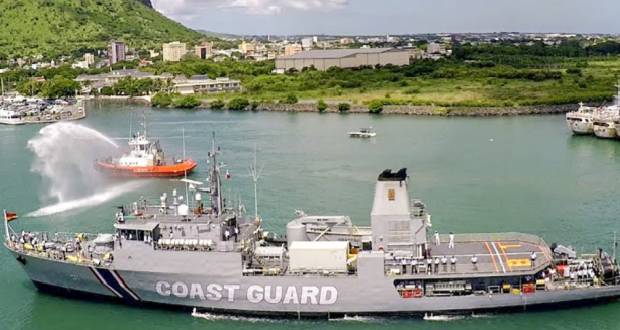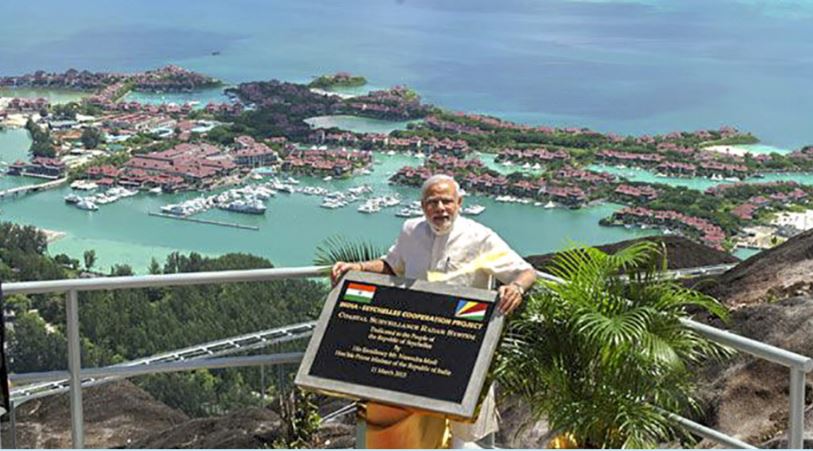Publicité
The $100 million line of credit from India: Not about Mauritius but... larger Indian regional ambitions
Par
Partager cet article
The $100 million line of credit from India: Not about Mauritius but... larger Indian regional ambitions

A $100 million line of credit offered by India to Mauritius back in February to purchase defence equipment is in the news again as well as on social media. Here is why the money offered by New Delhi is not so much about Mauritius but is more about India’s own larger ambitions for its arms export industry and the Indian Ocean region.
The $100 million offer
The $100 million line of credit to buy defence equipment offered to Mauritius by the Indian government via its EXIM bank back in February is back in the news as well as making the rounds on social media within the country. This offer was accompanied by another – for Mauritius to use a Dhruv helicopter and a Dornier plane for two years. “A line of credit is pretty much the same thing as a loan, but there are differences; a line of credit is much more flexible and normally there is a grant element to it,” former foreign secretary Vijay Makhan explains to l’express. Unlike a loan, a receiving state can choose when to use it, or whether to borrow from this facility at all. In the past, lines of credit have lapsed when the Mauritian government has been unwilling, or unable, to use them. One example was a Rs2.5 billion line of credit offered by the Agence française de développement between 2012 and 2018 to help finance the construction of Rivière-des-Anguilles dam. That facility was never used and simply lapsed. Therefore, there is a key difference between the $100 million facility offered by New Delhi and a loan. The other major element to keep in mind is that this line of credit is not something unique to Mauritius. At the same time the $100 million offer was made to Mauritius, the Indian government also offered the Maldives government a similar line of credit of $50 million for its own defence purchases.
Eye on strategy
It is not hard to see why Mauritius is one of the countries tapped by India to showcase its regional ambitions. Even before India developed its ambitions to become a major global arms exporter, Mauritius was already dependent on New Delhi for its security. After independence and the British exit, Mauritius swapped one security guarantor for another. In 1974, it signed a defence agreement with India, which among other things mandated that the heads of the Mauritius Coast Guard and the Mauritius Police Helicopter Squadron would be an Indian navy officer and an air force officer respectively. That has remained unchanged to date. India also gave Mauritius a ship to set up its coast guard, the Amar.
That defence tie-up between Port-Louis and New Delhi only deepened after the Lal Dora episode in 1983. According to Australian researcher David Brewster and India’s former Naval Intelligence director Ranjit Pai, fearing a coup against the Sir Anerood Jugnauth’s government by the MMM in 1983, then-Indian prime minister Indira Gandhi began preparations for a military landing in Port-Louis. She was also spooked by reports that Soviet ambassador in Seychelles Mikhail Orlov had approached Jugnauth’s political opponents promising to reorganize the Mauritian security services and offering to supply patrol boats for the Mauritian coast guard. The whole episode ended in fiasco after the 54th Indian army battalion marched from Hyderabad to Mumbai without informing the Indian navy supposed to bring them to Mauritius on the Mysore ship. The troops languished in an army base waiting to be taken to Mauritius until the whole plan came apart as the Indian army and navy could not decide who was calling the shots and the operation plans had been leaked to the US embassy in New Delhi.
Though it proved to be an embarrassing fiasco for New Delhi, the episode underscored for Mauritius that India was its ultimate security guarantor. Following the 1983 election, Sir Anerood Jugnauth’s then-government asked New Delhi to send Indian Army Major General J.N Taimini as national security adviser to the Mauritian government. Another tradition that has remained unchanged since then. “This relationship between India and Mauritius means that Mauritius has always been a very responsive partner for India. It has always been like that,” says Boolell, “India wants to be a major power and Mauritius has always been a facilitator of that; there are certain things that India expects Mauritius to do.”
Some of the foreign policy verities that Port-Louis is mandated to do is back India’s bid for a permanent seat on the UN Security Council or keep an eagle eye out for New Delhi’s strategic priorities. Such as in 1996 when Mauritius overruled its own cabinet decision to vote for a UN resolution on the Comprehensive Test Ban Treaty after New Delhi signalled its displeasure with the resolution, which it felt targeted its nuclear programme. 158 countries voted for the resolution, India, Bhutan and Libya voted against while Mauritius, Cuba, Syria, Tanzania and Lebanon abstained. The decision also led to a brief political crisis between the Labour Party and the MMM, who were then in an alliance. All this is to say that Mauritius has always supported larger Indian ambitions. Hence, it is not hard to see why today when India wants to recalibrate its strategy in the region, it naturally looks to Mauritius as an element in that.

New Delhi’s growing regional appetite
The money offered to Port-Louis has less to do with Mauritius, and more to do with India’s own ambitions in the Indian Ocean region. For years, wary of China and Russia’s growing clout within the region and encouraged by alreadyestablished powers, such as the US and France, India has sought to counter China’s deep pockets by trying to position itself as a foremost security provider in this region. As early as 2013, then-Indian prime minister Manmohan Singh declared, “Our defence cooperation has grown and today we have unprecedented access to high technology, capital and partnerships. We have also sought to assume our responsibility for stability in the Indian Ocean region. We are well-positioned, therefore, to become a net provider of security in our immediate region and beyond.”
Much the same thinking has been reproduced in current Narendra Modi’s 2016 Security and Growth for All in the Region (SAGAR) strategy. Part of this strategy is for New Delhi to court smaller states in the region. “India has been pulling in the small island developing states in the region to try to counter China and Russia,” says former foreign minister Arvin Boolell, “We’re going back to the bad old days of the cold war, but this time it is not ideological, it is more complex with a lot of other issues like piracy and illegal fishing thrown in and Mauritius is finding where it fits in this new pattern in the region.” How New Delhi has been trying to pull smaller regional states into its orbit was on display earlier this month at the Colombo Security Conclave, established in 2011 bringing together India, Sri Lanka and Maldives to jointly develop their maritime forces, carry out joint exercises and host regular meetings of their national security advisers. At its meeting this month, the trilateral grouping decided to invite Mauritius, Seychelles and Bangladesh to join as well. Something that New Delhi has long pushed for but was not possible until now because of recent tensions between India and Maldives’ Yameen government over the latter’s pro-China tilt as well as anger in Sri Lanka over Mauritius’ decision in 2013 to boycott a Commonwealth Heads of Government Meeting in Colombo to protest the Buddhist-majority country’s treatment of its predominantly Hindu Tamil minority. “This is the larger picture emerging and it’s not just about Mauritius and India, but a strategy being played out for the whole region,” states Makhan.

So, what does this have to do with the $100 million line of credit for defence materials offered to Mauritius this year? This is one of the ways New Delhi is looking to strengthen its regional influence by growing its own indigenous arms industry and go from the world’s second-largest arms importer (just behind Saudi Arabia) to emerge as a major arms exporter. In this, it wants to emulate other states such as China, South Korea, Turkey, Israel and Brazil. And the Indian Ocean region is a good place to start drumming up business. Currently, according to the Stockholm International Peace Research Institute (SIPRI), India accounts for 9.5 percent of total global arms imports, but only 0.2 percent of its exports between 2016 and 2020.
Therefore, one of the conditions attached to the $100 million line of credit to Mauritius is that Port-Louis buys 75 percent of defence equipment under the facility from Indian defence manufacturers. At the same time, as India was offering this facility to Mauritius and Maldives back in February, Indian defence minister Rajnath Singh indicated India’s willingness to supply weapons systems to regional countries during an Indian Ocean Region Defence Minister’s Conclave held in India: “India is ready to supply various types of weapons systems to IOR countries.” According to Makhan, “in Mauritius we tend to react to such offers emotionally forgetting that this is part of a much grander chessboard.” The line of credit offered to Mauritius, for Boolell, falls in line with India’s regional ambitions, “They have always said that this is their backyard and this line of credit to Mauritius is part of their agenda to give them more visibility and to send a strong signal.”
Carrots and sticks
If offers of Indian weaponry is a sign of New Delhi’s favour within the region, recent years have shown that they can also be a sign of fraying ties. One example is the story of two Dhruv helicopters supplied by India to Maldives in 2010 and 2015. As ties between India and Maldives became strained under the previous Abdulla Yameen government, seen as closer to China than Delhi, the Maldivian government demanded in 2018 that India take back the two helicopters manned by Indian crews. The crisis was ultimately resolved with Yameen’s replacement that year by Ibrahim Mohamed Solih, seen as pro-New Delhi. Although the helicopters stayed in Maldives, Solih is still struggling to contain anti-India sentiment within his country. Meanwhile that same year, as an agreement between Seychelles under the previous Danny Faure government and India for the construction of a military base on Assumption Island came under criticism, New Delhi attempted to salvage the agreement by offering a $100 million line of credit to Seychelles for infrastructure and defence purchases and gifted a Dornier plane to Seychelles. That, however, did not stop local opposition from forcing the Faure government to axe the Assumption Island deal with India, fraying ties between New Delhi and Seychelles.
This why when India offered lines of credit in February this year; it did so to Mauritius (which has pretty much implemented its own deal over Agalega seamlessly) and Maldives (under the friendlier Solih government) but did not offer anything to Seychelles. “This is not surprising, Solih has basically reversed Yameen’s pro-China policy and now Maldives and India have become close again; this is also signalling to Seychelles about how they could benefit by returning to the table as well,” says Boolell.
The showcase
Aside from traditionally enjoying a long defence and strategic relationship with New Delhi, another reason why Mauritius figures as one of the states to receive the line of credit offer is because it has long depended on and served as a showcase for Indian defence equipment. “Usually this has been about helicopters and patrol vessels or replacing worn defence equipment,” says Makhan. But the way that Mauritius has received such equipment has changed over the decades. In the 1970s, after the Amar, New Delhi donated nine patrol boats to Mauritius, replacing five of them in 2000 with similar boats built in its shipyards in Cochin. It gave another patrol boat to the Mauritian coast guard in 1993 (the Guardian), and an interceptor boat (the Observer) in 2001. The only other boats received by the Mauritian coast guard not coming from India were two Zhuk-class patrol boats (the Rescuer and the Retriever) from former USSR in 1990. That same year, India transferred a Dornier plane, followed by another in 2004. Until then, all these coast guard ships were second-hand vessels from the Indian armed forces..
More recently, however, the supply of Indian-made defence equipment to Mauritius has changed. In 2009, the Indian government offered a grant for Mauritius to buy a Dhruv helicopter, a third Dornier plane in 2016 through a $16 million line of credit and donated two refurbished Chetak helicopters that same year. In 2009, New Delhi gave Mauritius a grant to buy a coastal radar system from Indian company Bharat Electronics, dotted in Grand-Gaube, Pointe-du-Diable, Gris-Gris, Le Morne, Albion, Rodrigues, Les Salines, Agalega and St. Brandon, along with five other spots in Signal Mountain, QuarterMilitaire, Henrietta, Surinam and Pointe-du-Diable.

But it was the Barracuda deal that cemented Mauritius’ place as official showcase for Indian defence products. In 1996, Mauritius bought a new ship (the Vigilant) from the Asmar shipyard in Chile, but India was not far behind. In 2011, the Mauritian government signed a deal to buy the Kora-class ship (the Barracuda) from Garden Reach Shipbuilders and Engineers in Kolkata, India. The $58.5 million deal was financed through a $10 million grant from India and a $48.5 million loan from India’s EXIM bank. The deal was lauded and promoted in New Delhi as the first foreign purchase of an Indian-made warship. That was swiftly followed by another, again via a $27 million loan from India’s EXIM bank for 10 interceptor boats and two patrol vessels (the Victory and the Valiant) from Goa Shipyard Limited in 2014.
According to SIPRI, between 1990 and 2020, 64 percent of Mauritian defence spending was done buying Indian wares. It is a profitable relationship: “Mauritius gets what it wants in terms of defence equipment and India sees Mauritius helping fulfil its security and strategic goals,” says Makhan. In this case, advertising the benefits of good relations with New Delhi and affording it an opportunity to advertise its defence wares. So, India’s extending once again a line of credit for yet more defence equipment is neither new, nor surprising. Neither should it be a mystery about why India is looking at Port-Louis as one of the countries to help fulfil its ambition to become a regional security and defence supplier.

The question now is: while India is willing to extend the $100 million line of credit, is the Mauritian economy battered by Covid-19 – with government debt climbing to 85.9 percent of GDP by last June – in a position to add yet more to its loan books and take up the offer? “The thing that has to be debated is: CAN we afford this?” asks Makhan. Regardless of the strategy behind it, Boolell reminds us that “there is after all, no such thing as a free lunch”.
Publicité
Publicité
Les plus récents






